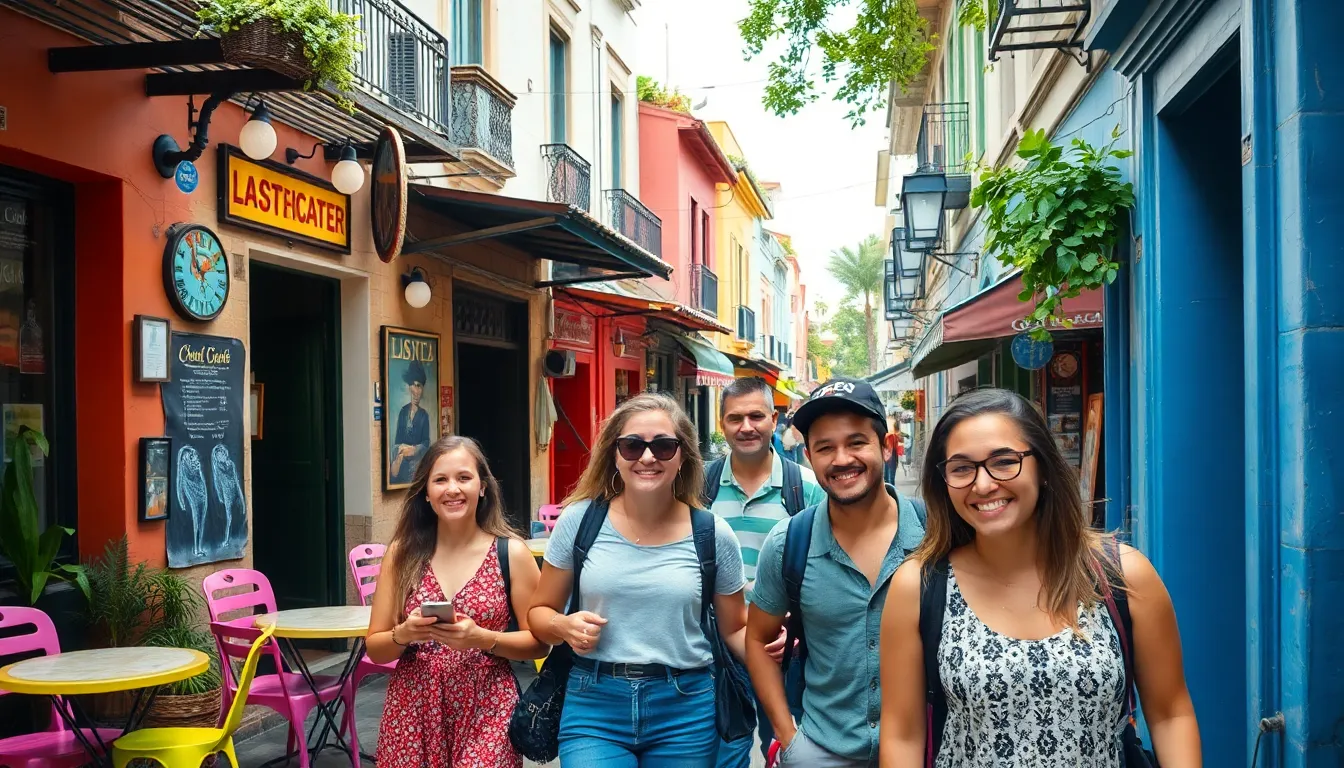Table of Contents
ToggleIn a world where the journey often matters more than the destination, “Roaming Paths” invites exploration beyond the beaten track. This concept encourages individuals to embrace the unknown, discovering hidden gems and unique experiences along the way. Whether it’s wandering through vibrant city streets or hiking in serene nature, the allure of uncharted territories captivates adventurers and dreamers alike.
Roaming paths symbolize freedom and curiosity, allowing travelers to break free from routine and immerse themselves in diverse cultures and landscapes. As they navigate these winding routes, they uncover stories that enrich their lives and broaden their perspectives. Join the journey as we delve into the essence of roaming paths and the transformative power they hold.
Overview of Roaming Paths
Roaming paths refer to routes that deviate from conventional trails, often leading to unique discoveries. These journeys foster exploration, curiosity, and personal growth.
Definition and Concept
Roaming paths embody any route taken outside established or well-known trails. They include spontaneous adventures in urban settings, hiking lesser-known nature trails, or navigating side streets in new towns. These paths challenge travelers to engage with their surroundings, discovering local culture, hidden nature spots, and architectural wonders. Such journeys offer an opportunity for personal reflection and enhanced appreciation of diverse environments.
Importance in Modern Navigation
Roaming paths hold significant value in modern navigation. As travelers increasingly seek authentic experiences, these routes encourage exploration beyond tourist hotspots. Embracing unfamiliar paths fosters creativity and raises awareness of local communities and cultures. Furthermore, technology supports this exploration through GPS tools and navigation apps. These tools help individuals identify off-the-beaten-path locations, enhancing their experiences while promoting mindful travel. As travelers embrace roaming paths, they contribute to sustainable tourism by supporting local businesses and preserving natural habitats.
Types of Roaming Paths

Roaming paths come in various forms, each offering unique experiences and opportunities for exploration. Travelers can engage with their surroundings through physical and digital avenues.
Physical Roaming Paths
Physical roaming paths include both urban and natural environments where individuals venture off established routes. These paths encourage unexpected encounters, from stumbling upon local markets in vibrant neighborhoods to discovering serene trails in secluded parks. Examples of these paths include:
- Urban Side Streets: Navigating lesser-known city streets leads to hidden cafes, street art, and local shops.
- Nature Trails: Exploring off-the-beaten-path hiking trails reveals breathtaking landscapes and diverse flora and fauna.
- Cultural Routes: Walking through historical districts offers insights into local heritage, architecture, and traditions.
Physical roaming paths stimulate curiosity, foster connections with the environment, and enhance personal growth through immersive experiences.
Digital Roaming Paths
Digital roaming paths leverage technology to uncover unique experiences and destinations. These paths utilize GPS tools and navigation apps, allowing travelers to identify lesser-known locales easily. Examples of digital roaming paths include:
- Travel Apps: Utilizing platforms like Google Maps or TripAdvisor to find user-generated content on hidden gems.
- Social Media: Following travel influencers on platforms like Instagram or TikTok for real-time recommendations and local insights.
- Online Forums: Engaging with communities on sites like Reddit or travel blogs to discover unconventional itineraries and tips.
Digital roaming paths empower travelers to access information and connect with others, making exploration more accessible and enriching.
Applications of Roaming Paths
Roaming paths find application across various sectors, particularly in travel and urban development. These applications enhance experiences and strategies, promoting exploration and sustainability.
Use in Travel and Tourism
Roaming paths significantly enrich travel experiences by encouraging exploration beyond traditional tourist destinations. Tourists seeking authentic local culture often discover hidden cafes, local artisans, and historic sites along these routes. Travel companies increasingly incorporate roaming paths into itineraries, offering bespoke tours that highlight unique experiences.
Technology facilitates this exploration through travel apps that provide curated suggestions for off-the-beaten-path attractions. An example is the app AirBnb Experiences, which connects travelers with local hosts, guiding them through undiscovered locales. Additionally, marketers leverage user-generated content on social media to showcase these adventures, appealing to adventure-seeking travelers.
Impacts on Urban Planning
Roaming paths also influence urban planning by integrating flexible and accessible routes into city designs. Planners incorporate pedestrian-only zones and bike lanes to encourage exploration of less-visited areas, enhancing community engagement. Cities like Amsterdam utilize roaming paths to promote cycling, connecting neighborhoods that might otherwise remain isolated.
Moreover, parks and green spaces are designed to include winding trails that invite leisurely strolls and exploration. These paths contribute to improved mental and physical well-being, as studies show that access to natural spaces enhances quality of life. Urban planners collaborate with local communities to identify potential roaming paths, ensuring developments resonate with resident needs and cultural significance.
Benefits and Challenges
Roaming paths offer both significant advantages and notable challenges in their development. Understanding these aspects helps individuals and communities maximize their benefits while addressing potential obstacles.
Advantages of Implementing Roaming Paths
- Enhanced Exploration: Roaming paths encourage deeper engagement with environments, allowing individuals to discover hidden gems that typical routes might overlook.
- Cultural Insights: Travelers gain a more authentic view of local cultures through interactions with residents, unique eateries, and local art, fostering richer experiences.
- Support for Local Economies: Off-the-beaten-path exploration supports small businesses such as local cafes, shops, and artisans, contributing to economic sustainability in communities.
- Promotes Wellbeing: Physical roaming paths like walking trails and parks enhance physical health and mental well-being by encouraging outdoor activity and reducing stress.
- Sustainability: Roaming paths can lead to sustainable tourism practices, ensuring environmental preservation by distributing foot traffic and reducing strain on popular attractions.
- Community Engagement: Development participants often work together, fostering a sense of community ownership and pride in local spaces.
Challenges Faced in Roaming Path Development
- Funding and Resources: Securing financial support for development can be difficult, requiring collaboration with local businesses, governmental grants, or crowdfunding.
- Navigational Clarity: Ensuring users can easily navigate roaming paths involves clear markers and accessible maps, which require significant planning and maintenance.
- Safety Concerns: Addressing safety issues such as crime or poor lighting on less-populated paths remains a critical challenge for urban planners and local authorities.
- Environmental Impact: Balancing exploration with conservation needs careful planning to minimize ecological disruptions in natural areas.
- Community Resistance: Engaging local communities in the planning process is essential, as resistance may arise if residents feel excluded from decisions that affect their neighborhoods.
- Technological Dependence: While digital tools facilitate exploration, over-reliance on technology can detract from the immersive experience of roaming paths.
The Future of Roaming Paths
The future of roaming paths centers on technological innovations and evolving travel behaviors. As explorers seek authenticity, advancements in technology and emerging trends shape their journeys.
Technological Advancements
Technology plays a pivotal role in enhancing roaming paths. Mobile applications provide real-time navigation, enabling users to discover unique sites that traditional maps overlook. Features like augmented reality (AR) offer interactive experiences, allowing travelers to visualize information about a location through their devices. GPS-enabled tools enable users to share and access curated itineraries, enhancing collaboration among explorers. Wearable devices, such as smartwatches, facilitate hands-free navigation, empowering individuals to immerse themselves fully in their surroundings. Furthermore, machine learning algorithms analyze traveler preferences, personalizing recommendations and promoting relevant off-the-beaten-path destinations.
Predictions and Trends
Predictions indicate a growing emphasis on sustainability and local engagement within roaming paths. Travelers will seek to minimize their environmental footprint, prompting a rise in eco-friendly travel options that prioritize conservation. Community-driven initiatives will increase, facilitating collaborations between local businesses and explorers. Additionally, trends such as slow travel will gain momentum, promoting deeper connections with destinations through longer stays and immersive experiences. Virtual reality (VR) might emerge as a preparatory tool, offering glimpses into potential adventures before embarking. As urban planners integrate roaming paths in city designs, walkable neighborhoods and accessible natural areas will enhance quality of life and encourage exploration. These developments will foster a culture of curiosity, ensuring the future of roaming paths continually evolves to meet travelers’ desires.
Roaming paths offer a unique lens through which to explore the world. They invite individuals to step outside their comfort zones and discover the richness of their surroundings. By embracing these unconventional routes travelers not only enrich their experiences but also foster a deeper connection with local cultures and communities.
As technology continues to evolve so do the opportunities for exploration. The integration of digital tools enhances the journey making it easier for adventurers to uncover hidden gems. This shift towards mindful travel promotes sustainability and supports local economies while encouraging a spirit of curiosity.
Ultimately the allure of roaming paths lies in their ability to transform ordinary journeys into extraordinary adventures. By choosing to wander off the beaten path individuals can unlock a world of discovery that enhances their lives in meaningful ways.





